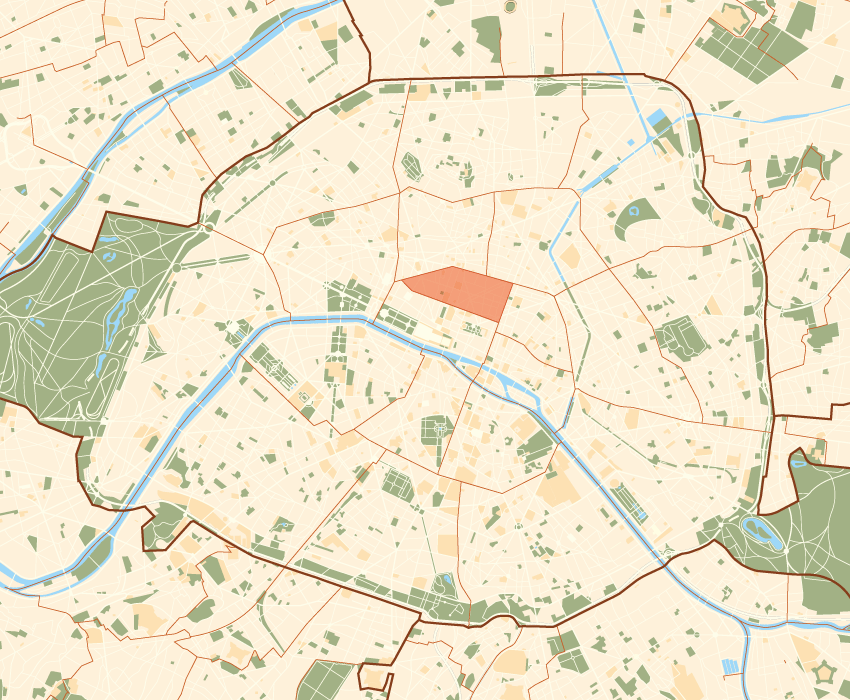- 2nd arrondissement of Paris
French municipal arrondissement
arrondissementnumber=2nd
commune=Paris
caption=The formerParis Bourse , located in the 2nd arrondissement.
mapcaption=Paris and its closest suburbs
lat_long=
région=Île-de-France
département=Paris
maire=Jacques Boutault
alt mini=|alt maxi=
km²=0.99
sans=
20,700
19,585
date-sans=July 1, 2005 estimate)
(March 8, 1999 census|dens=20,867|date-dens=2005|The 2nd arrondissement ("2e arrondissement") is one of the 20 arrondissements ofParis , the capital city ofFrance . Located on the right bank of the River Seine, the 2nd arrondissement, together with the adjacent 8th and 9th arrondissements, hosts an important business district, centred on the Paris Opéra, which houses the city's densest concentration of business activities. The arondissement contains the formerParis Bourse (stock exchange ) and a large number of banking headquarters, as well as a textile district, known as theSentier , and theOpéra-Comique concert hall.The 2nd arrondissment is also the home of all of Paris's surviving 19th-century glazed commercial arcades. At the beginning of the 19th century most of the streets of Paris were dark and muddy and lacked
sidewalk s. A few entrepreneurs copied the success of thePassage des Panoramas and its well-lit, dry and paved pedestrian passageways. By the middle of the 19th century there were about two dozen of these commercial malls, but most of them disappeared as the Paris authorities paved the main streets, added sidewalks and gas street lighting. The commercial survivors are – in addition to the Passage des Panoramas – the Galerie Vivienne, the Passage Choiseul, the Galerie Colbert, the Passage des Princes, the Passage du Grand Cerf, the Passage du Caire, the Passage Lemoine, the Passage Jouffroy, the passage Basfour, the passage du Bourg-L'abbé, and the Passage du Ponceau.Geography
The 2nd arrondissement is Paris's smallest arrondissement, with a land area of just 0.992 km² (0.383 sq. miles, or 245 acres)
Demographics
The 2nd arrondissement reached its peak of settlement in the years before 1861, although it has only existed in its current shape since the re-organization of Paris in 1860. As of the last census (in 1999), the population was 19,585, while the number of jobs provided there was 61,672 – this despite a land area of only 0.992 km², making it the arrondissement with the densest concentration of commercial activity in the capital, with an average of 62,695 jobs per km².
Historical population
¹The peak of population actually occurred before 1861, but theYear
(of French censuses)Population Density
(inh. per km²)1861 (peak of population)¹81,609 82,267 1872 73,578 74,321 1954 41,780 44,300 1962 40,864 41,194 1968 35,357 35,642 1975 26,328 26,540 1982 21,203 21,374 1990 20,738 20,905 1999 19,585 19,743 2005 20,700 20,867
arrondissement was created in 1860, so we do not have figures before 1861.Immigration
France immigration
collectivity_name=the 2nd arrondissement
census_year=1999
metropolitan_France=71.4
outside_metropolitan_France=28.6
overseas_France=0.8
foreign_French=3.8
EU-15=6.1
non-EU-15=17.9Map
Cityscape
Places of interest in the arrondissement
*
Paris stock exchange (Palais Brongniart , former headquarters)
*Bibliothèque nationale de France historical building ("site Richelieu") ("Monument historique")
*Passage des Panoramas
*Opéra-Comique
*Théâtre des Bouffes Parisiens
*Théâtre des Variétés
*Théâtre-Musée des Capucines , a perfume museum
*Café de la Paix Main streets and squares
*
Boulevard de Bonne-Nouvelle
*Place de la Bourse
*Boulevard des Capucines
*Rue des Capucines
*Rue de Cléry
*Rue Étienne-Marcel
*Rue du Faubourg-Montmartre
*Boulevard des Italiens
*Rue du Louvre
*Rue Monsigny
*Boulevard Montmartre
*Rue Montmartre
*Rue Montorgueil
*Rue Notre-Dame des Victoires
*Avenue de l'Opéra (partial)
* Rue de la Paix
*Rue des Petits-Champs
*Boulevard Poissonnière
*Rue du Quatre-Septembre
*Rue Réaumur
*Rue de Richelieu (partial)
*Boulevard Saint-Denis
* Rue Saint-Denis
*Rue Saint-Sauveur
*Boulevard Sébastopol
*Rue de Turbigo
*Place des Victoires (partial)References
* Le "Guide du routard" 2006: Paris.
* "54 Promenades en Famille. A Paris et en Ile-de-France."
Wikimedia Foundation. 2010.
